Experimental Research of the Time-Dependent Effects of Steel–Concrete Composite Girder Bridges during Construction and Operation Periods
Abstract
1. Introduction
2. Background Project Overview
2.1. Bridge Overview
2.2. Structural Health Monitoring (SHM) System
3. Thermal Effect during the Construction Process
3.1. Variation Law of Girder Temperature
3.2. Variation Law of Girder Strain
3.3. Proposed Gradient Model of Temperature
4. Concrete Creep Effect during the Construction and Operation Periods
4.1. Concrete Creep Experiment
4.1.1. Concrete Specimen
4.1.2. Creep Experiment Process
4.1.3. Experimental Results
4.2. Prediction Method of the Concrete Creep Effect
4.3. Elaborate FE Model
4.4. Predicted Long-Term Effects of Concrete Creep
5. Conclusions
- (1)
- The daily temperature variations in the composite girder and the corresponding influence law were studied. The temperature variation trends of the steel beam and concrete slab were characterized by sinusoidal curves without temperature lag. In addition, the heating rate of the concrete slab was higher than the cooling rate. The rates of heating and cooling of the concrete slab first increased and then decreased. Moreover, the suggested temperature gradient model for composite girder bridges in the Hebei Province of China was proposed with a guaranteed rate of 95% by processing the maximum temperature difference during a single day.
- (2)
- A concrete creep experiment under uniaxial compression was carried out using the same batch of concrete material as that used for the bridge. A creep degree function of concrete was obtained. The concrete creep effect of the composite girder bridge was predicted by integrating the age-adjusted effective modulus method and FE model. The accuracy of the numerical analysis was verified by comparing the calculated and monitoring results of girder deflections and strains. The prediction results show that the internal force of the concrete slab in the negative bending moment zone decreased, and the stress of the steel beam increased gradually. The concrete slab in the positive bending moment zone was continuously involved in load bearing. The compression part of the steel beam decreased gradually. However, the internal force of the lower flange of the steel beam in the positive bending moment zone still increased because of the stiffness reduction in the negative moment zone.
- (3)
- The internal force change in the composite girder was characterized by three stages. The stress changes during the first 10 days were significant, the stress change rate decreased continuously during days 10–90, and the stress changed slowly and smoothly after 90 days. The bending moment change in the stud along the longitudinal direction was characterized by a sinusoidal distribution. The stud bending moment was the largest in Section S3. The stud bending moment near the 3rd pier section increased gradually as a result of concrete creep, and the stud bending moments in the other sections decreased gradually.
Author Contributions
Funding
Acknowledgments
Conflicts of Interest
References
- Editorial Department of China Journal of Highways. Summary of Academic Research on Bridge Engineering in China 2014. China J. Highw. 2014, 27, 1–96. [Google Scholar]
- Wang, J.Q.; Lv, Z.T.; Liu, Q.W.; Wang, F. Monitoring and numerical analysis of steel-concrete continuous composite girder bridge construction. In Proceedings of the China Bridge Society Bridge and Structural Engineering Branch 2005 National Bridge Conference, Hangzhou, China, 24–25 October 2005. [Google Scholar]
- Li, X. Construction Control Technology of Steel-Concrete Composite Continuous Box Girder Bridge. Master’s Thesis, Chongqing Jiaotong University, Chongqing, China, 2015. [Google Scholar]
- Sun, T. Deformation analysis of steel-concrete composite beams during construction. J. Lanzhou Univ. Technol. 2011, 37, 107–109. [Google Scholar]
- Tan, W.H.; Li, D. Monitoring and analysis of steel-composite composite beam deformation. In Proceedings of the 16th National Conference on Structural Engineering, Taiyuan, Shaanxi, China, 17–19 August 2007. [Google Scholar]
- Chen, Y.J.; Ye, M.X. Response analysis of steel-concrete composite beam under temperature. China Railw. Sci. 2001, 22, 48–53. [Google Scholar]
- Gu, P.; Shi, Q.C. Analysis of temperature effect of external prestressed steel-concrete composite girder bridge. J. Highw. Transp. 2008, 25, 55–59. [Google Scholar]
- Zhou, L.; Lu, Y.C.; Li, X.F. The calculation of temperature stress of steel-concrete composite beam. J. Highw. Transp. 2012, 29, 83–88. [Google Scholar]
- Liu, Y.J.; Liu, J.; Zhang, N.; Feng, B.W.; Xu, L. Analytical solution of temperature effect of steel-concrete composite beams. J. Traffic Transp. Eng. 2017, 17, 9–19. [Google Scholar]
- Chen, Y.J.; Wang, L.B.; Li, Y. Study on temperature field and temperature effect of steel-concrete composite girder bridge. J. Highw. Transp. 2014, 31, 85–91. [Google Scholar]
- Su, J.H.; Duan, S.J. Study on sunlight temperature effect of steel-concrete double-sided composite box girder. J. Shijiazhuang Railw. Univ. 2013, 26, 11–14. [Google Scholar]
- Wang, Z.X. Analysis of Temperature Effect during Construction of Steel-Concrete Composite Girder Cable-Stayed Bridge in Alpine Region. Master’s Thesis, Chang’an University, Xi’an, Shanxi, China, 2017. [Google Scholar]
- Xiao, L.; Liu, L.F.; Wei, X. Temperature field analysis of steel-concrete composite girder bridge. In Proceedings of the China Steel Structure Association Structural Stability and Fatigue Branch 16th (ISSF-2018) Academic Exchange Conference and Teaching Seminar, Qingdao, Shandong, China, 2–14 September 2018. [Google Scholar]
- Hui, R.Y.; Huang, G.X.; Yi, B.R.; Shen, J.H. Experimental study on concrete triaxial creep. China J. Hydraul. Eng. 1993, 7, 75–80. [Google Scholar]
- Zhou, L. Internal force redistribution of steel-concrete composite beams caused by shrinkage and creep of concrete. Bridge Constr. 2001, 2, 1–4. [Google Scholar]
- Liu, X.; Erkmen, R.E.; Bradford, M.A. Creep and shrinkage analysis of curved composite beams with partial interaction. Int. J. Mech. Sci. 2012, 58, 57–68. [Google Scholar] [CrossRef]
- Chen, D.K.; Hu, B. Time-dependent analysis and fracture of steel-concrete composite structure. J. Harbin. Technol. 2003, 35, 123–128. [Google Scholar]
- Zhao, M.; Wang, X.M.; Gao, J. Finite element numerical analysis of prestressed concrete structures. J. Shijiazhuang Railw. Univ. 2004, 17, 84–88. [Google Scholar]
- Macorini, L.; Fragiacomo, M.; Amadio, C.; Izzuddin, B.A. Long-term analysis of steel–concrete composite beams: FE modelling for effective width evaluation. Eng. Struct. 2005, 28, 1110–1121. [Google Scholar] [CrossRef]
- Gara, F.; Ranzi, G.; Leoni, G. Time analysis of composite beams with partial interaction using available modelling techniques: A comparative study. J. Constr. Steel Res. 2006, 62, 917–930. [Google Scholar] [CrossRef]
- Miao, L.; Chen, D.W. Calculation of long-term performance of beams considering shear lag effect. Eng Mech. 2012, 29, 252–258. [Google Scholar]
- Zhao, G.Y.; Xiang, T.Y.; Xu, T.F.; Zhan, Y.L. Stochastic analysis of shrinkage and creep effects of steel-concrete composite beams. China J. Comput. Mech. 2014, 31, 67–71. [Google Scholar]
- Lu, Z.F.; Liu, M.Y.; Li, Q. Analysis of creep effect of steel-composite composite continuous beam bridge considering temperature and humidity changes. J. Cent South Univ. Sci. Technol. 2015, 46, 2650–2657. [Google Scholar]
- Zhou, G.P.; Li, A.Q.; Li, J.H.; Duan, M.J. Structural health monitoring and time-dependent effects analysis of self-anchored suspension bridge with extra-wide concrete girder. Appl. Sci. 2018, 8, 115. [Google Scholar] [CrossRef]
- Zhou, G.P.; Li, A.Q.; Li, J.H.; Duan, M.J.; Spencer, B.F.; Zhu, L. Beam finite element including shear lag effect of extra-wide concrete box girders. J. Bridge Eng. 2018, 23, 04018083. [Google Scholar] [CrossRef]
- Zhou, G.P.; Li, A.Q.; Li, J.H.; Duan, M.J. Health monitoring and comparative analysis of time-dependent effect using different prediction models for self-anchored suspension bridge with extra-wide concrete girder. J. Cent South Univ. 2018, 25, 2025–2039. [Google Scholar] [CrossRef]
- Gara, F.; Ranzi, G.; Ansourian, P. General method of analysis for composite beams with longitudinal and transverse partial interaction. Comput Struct. 2006, 84, 2373–2384. [Google Scholar]
- Ranzi, G. Short—And long-term analyses of composite beams with partial interaction stiffened by a longitudinal plate. Steel Compos. Struct. 2006, 6, 237–255. [Google Scholar] [CrossRef]
- Ranzi, G.; Bradford, M.A. Analytical solutions for the time-dependent behaviour of composite beams with partial interaction. Int. J. Solids Struct. 2005, 43, 3770–3793. [Google Scholar] [CrossRef]
- Sullivan, R.W. Using a Spectrum Function Approach to Model Flexure Creep in Viscoelastic Composite Beams. Mech. Adv. Mater. Struct. 2012, 19, 39–47. [Google Scholar] [CrossRef]
- Fan, J.S.; Nie, J.G.; Wang, H. Study on long-term mechanical behavior of composite beams considering shrinkage, creep and cracking (I): Experiment and calculation. J. Civil Eng. 2009, 42, 8–15. [Google Scholar]
- Fan, J.S.; Nie, X.; Li, Q.W. Study on long-term mechanical behavior of composite beams considering shrinkage, creep and cracking (II): Theoretical analysis. J. Civil Eng. 2009, 42, 16–22. [Google Scholar]
- Bazant, M.Z.; Kaxiras, E.; Justo, J.F. The environment-dependent interatomic potential applied to silicon disordered structures and phase transitions. MRS Proc. 1997, 491, 339–345. [Google Scholar] [CrossRef]
- Justo, J.F.; Bazant, M.Z.; Kaxiras, E.; Bulatov, V.V.; Yip, S. Interatomic potential for condensed phases and bulk defects in silicon. MRS Proc. 1997, 469, 217–227. [Google Scholar] [CrossRef]
- Bazant, Z.P.; Hauggaard, A.B.; Baweja, S.; UIm, F.J. Microprestress-solidification theory for concrete creep. (I): Aging and drying effects. J. Eng. Mech. 1997, 123, 1189–1194. [Google Scholar]
- Bazant, Z.P.; Hauggaard, A.B.; Baweja, S. Microprestress-solidification theory for concrete creep. (II): Algorithm and verification. J Eng. Mech. 1997, 123, 1195–1201. [Google Scholar] [CrossRef]
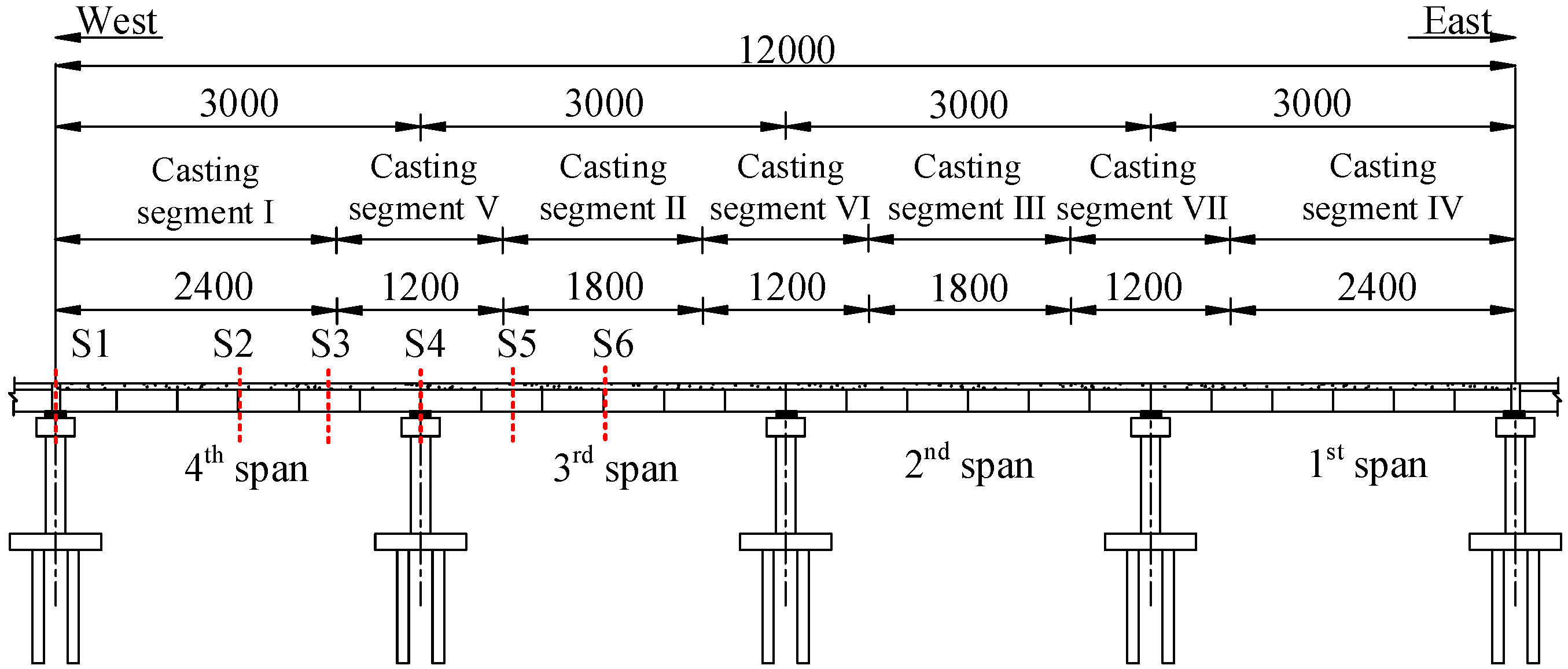
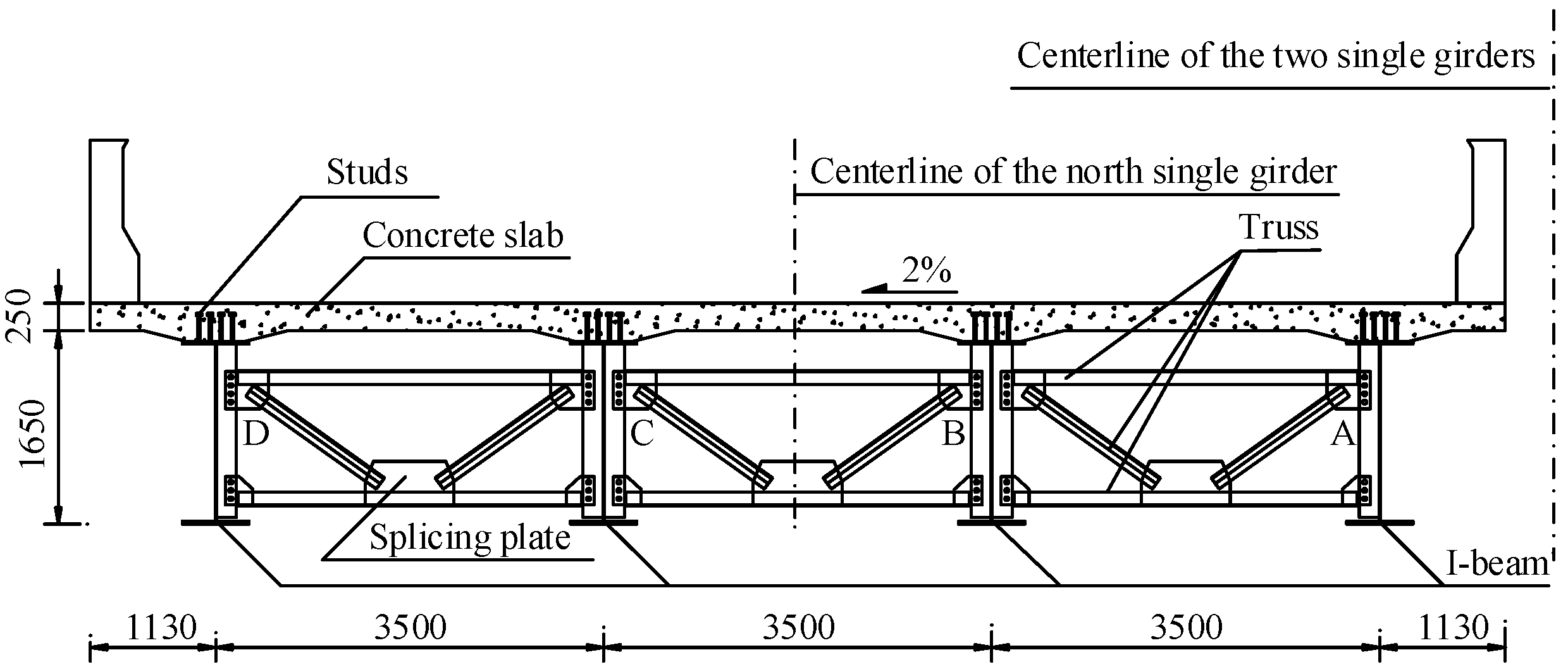
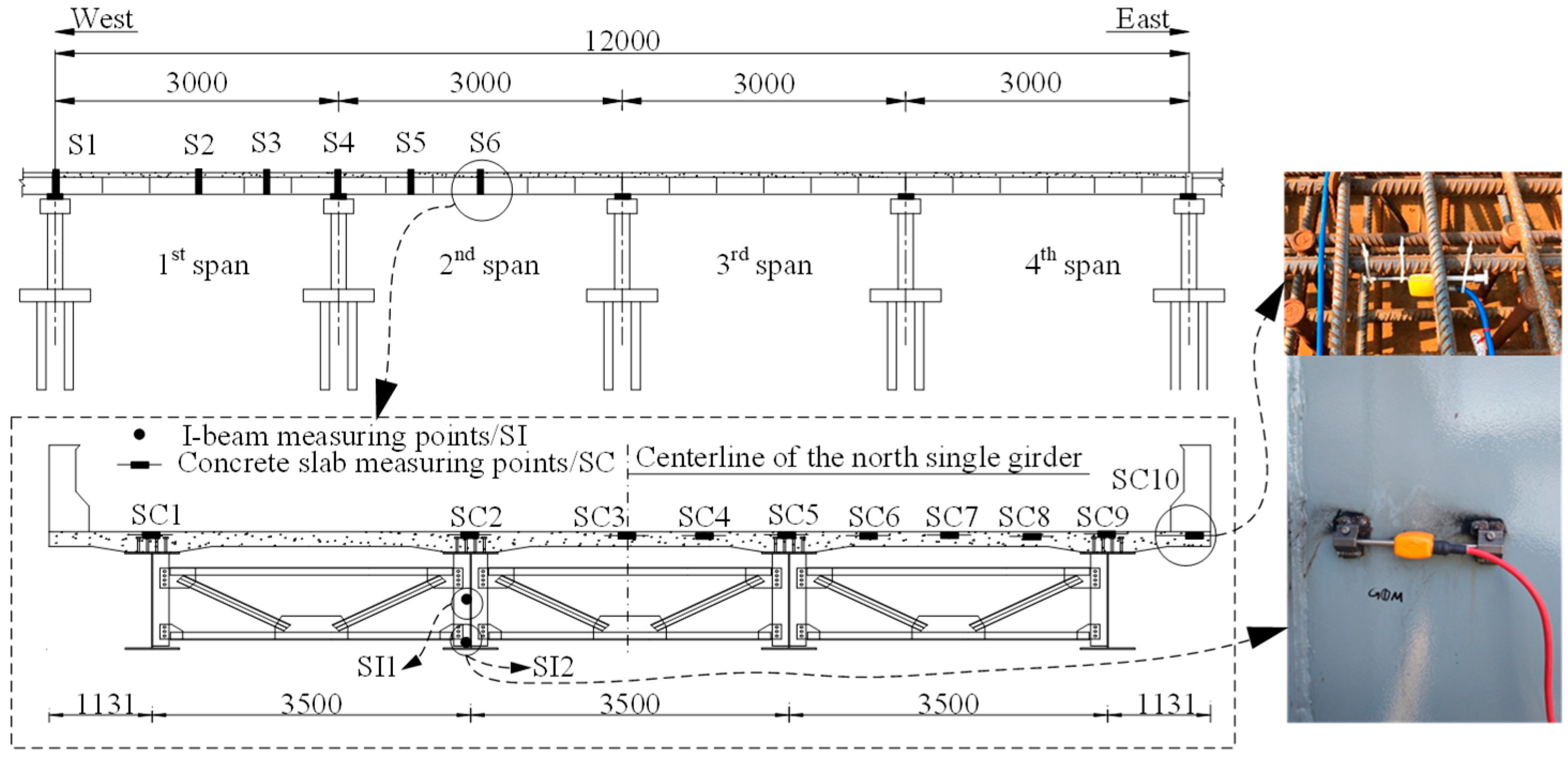

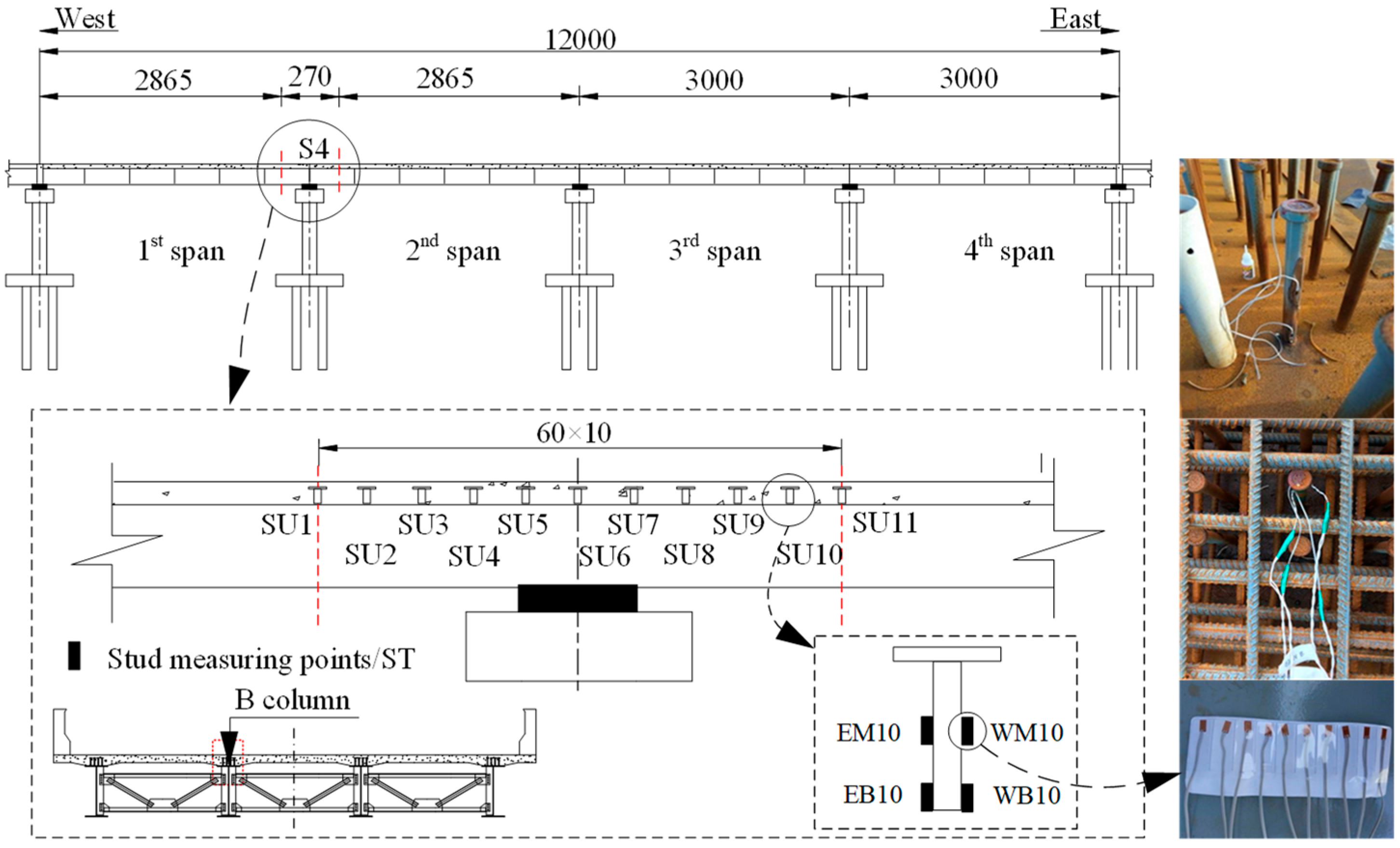
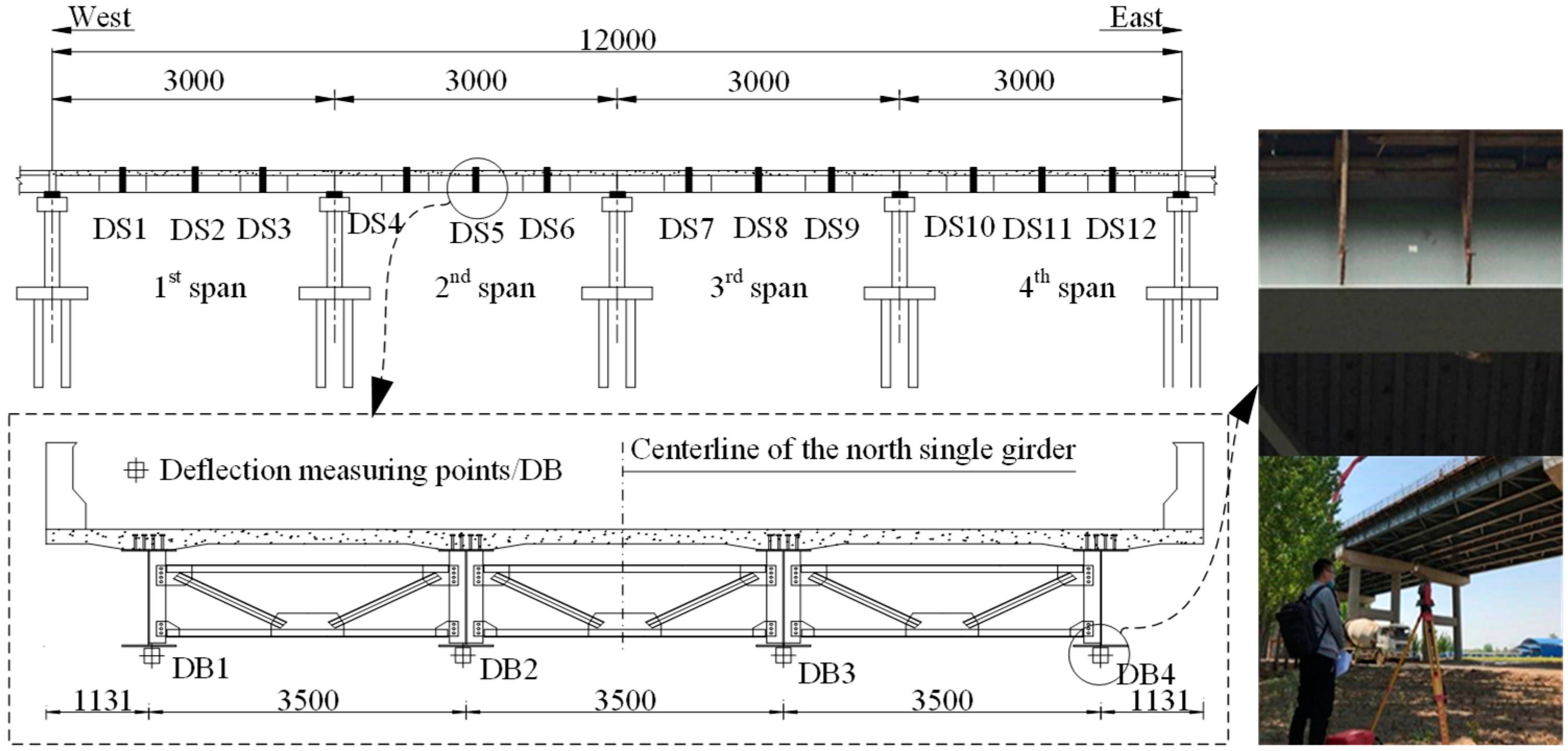

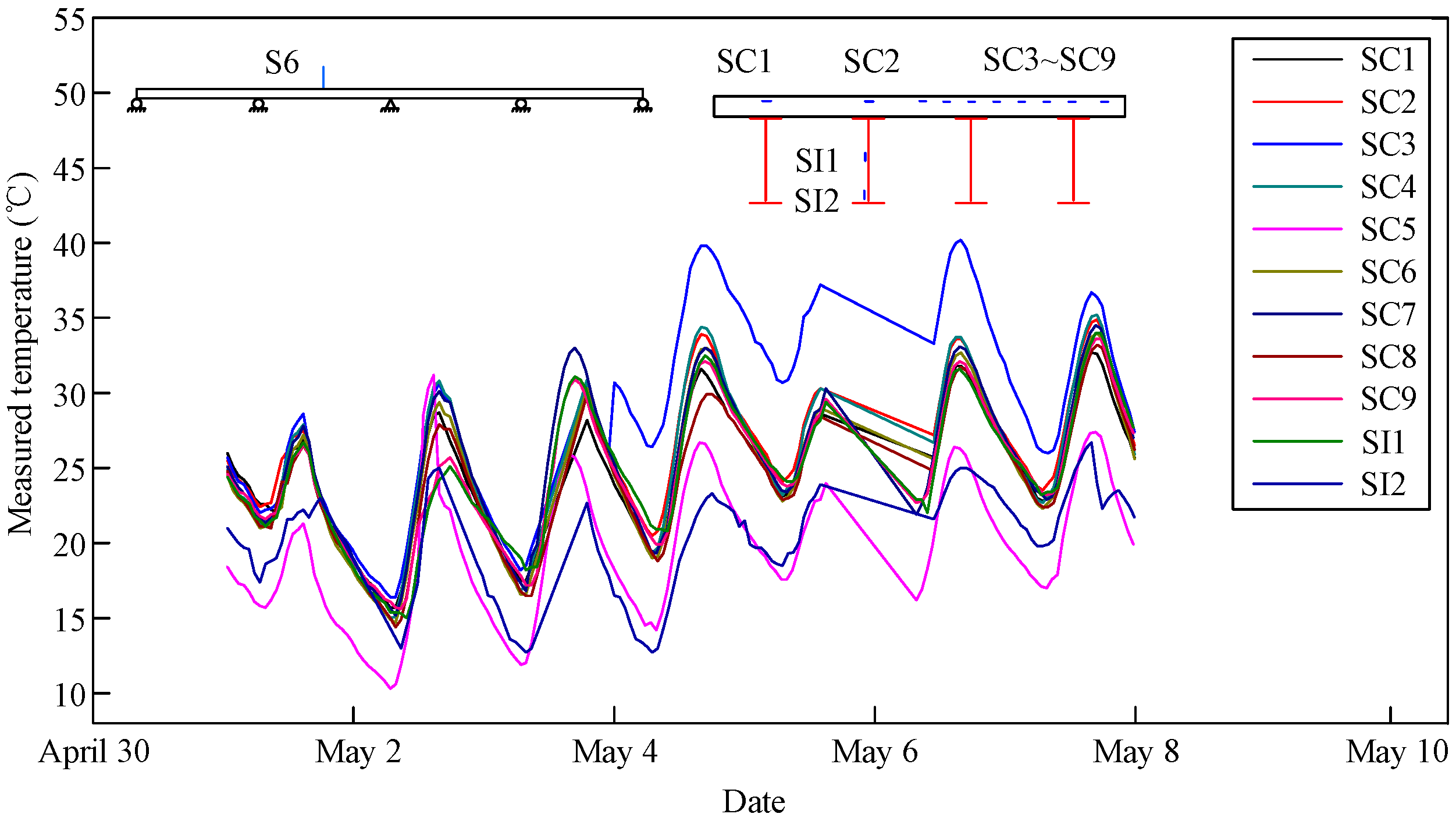



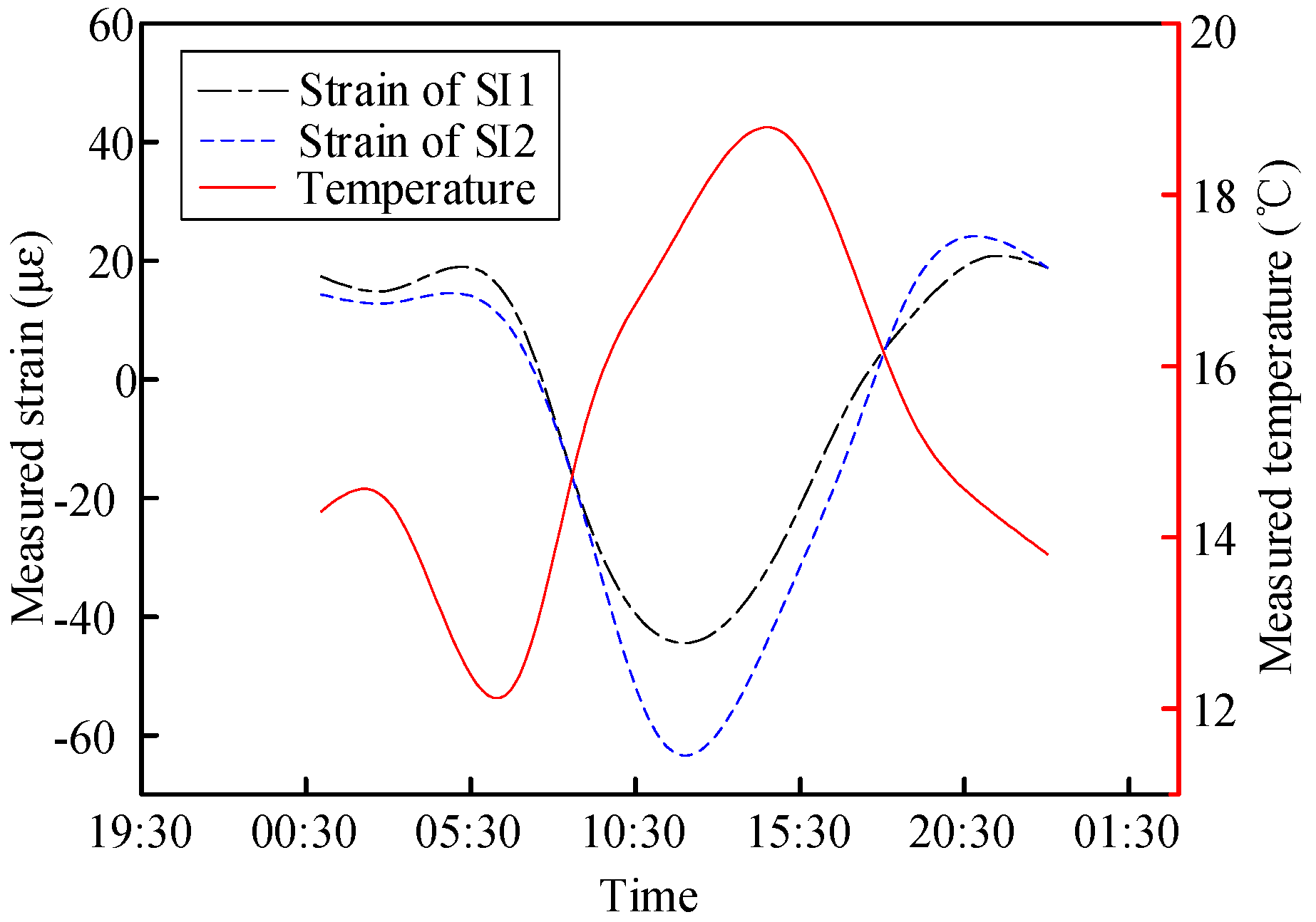
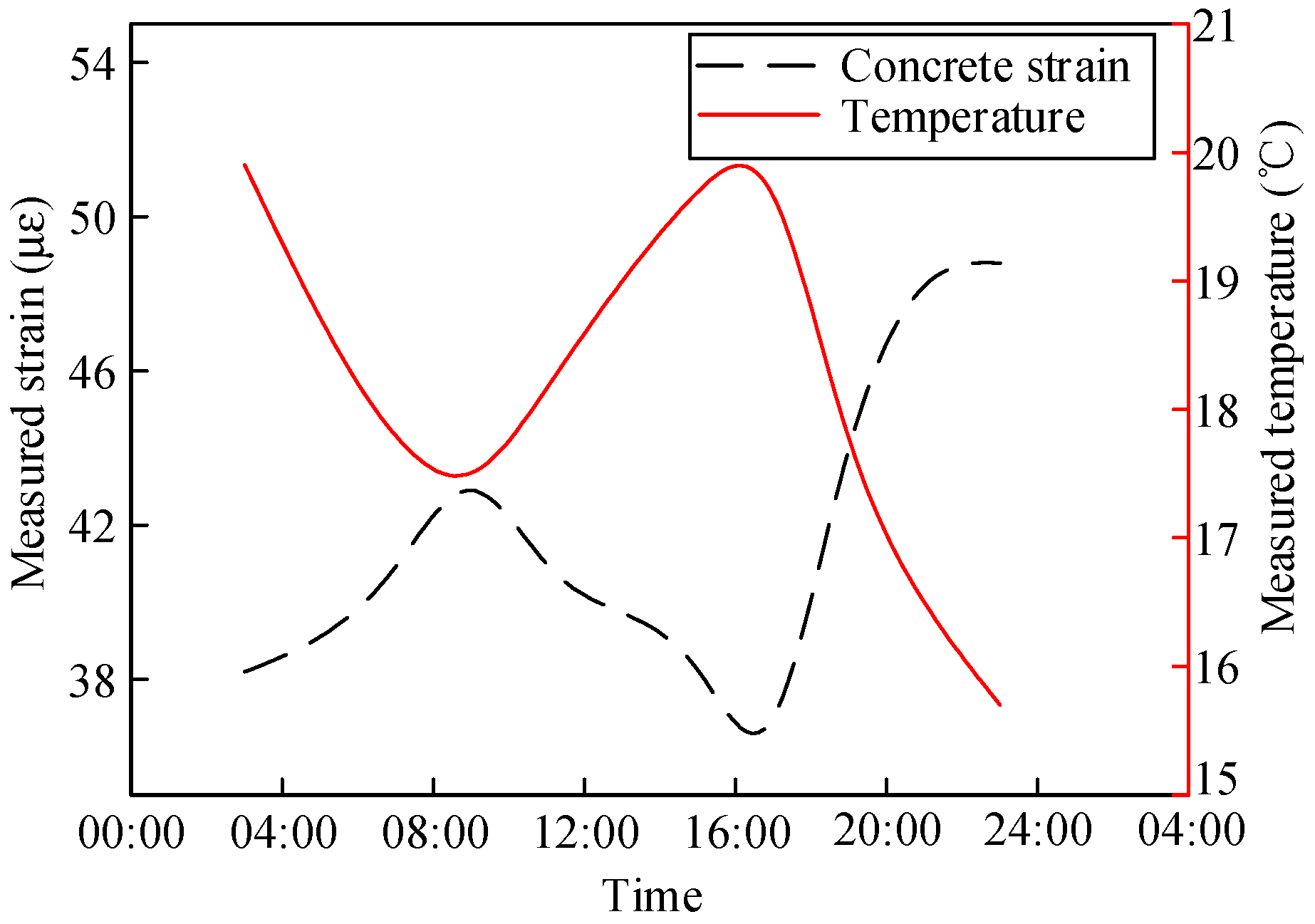


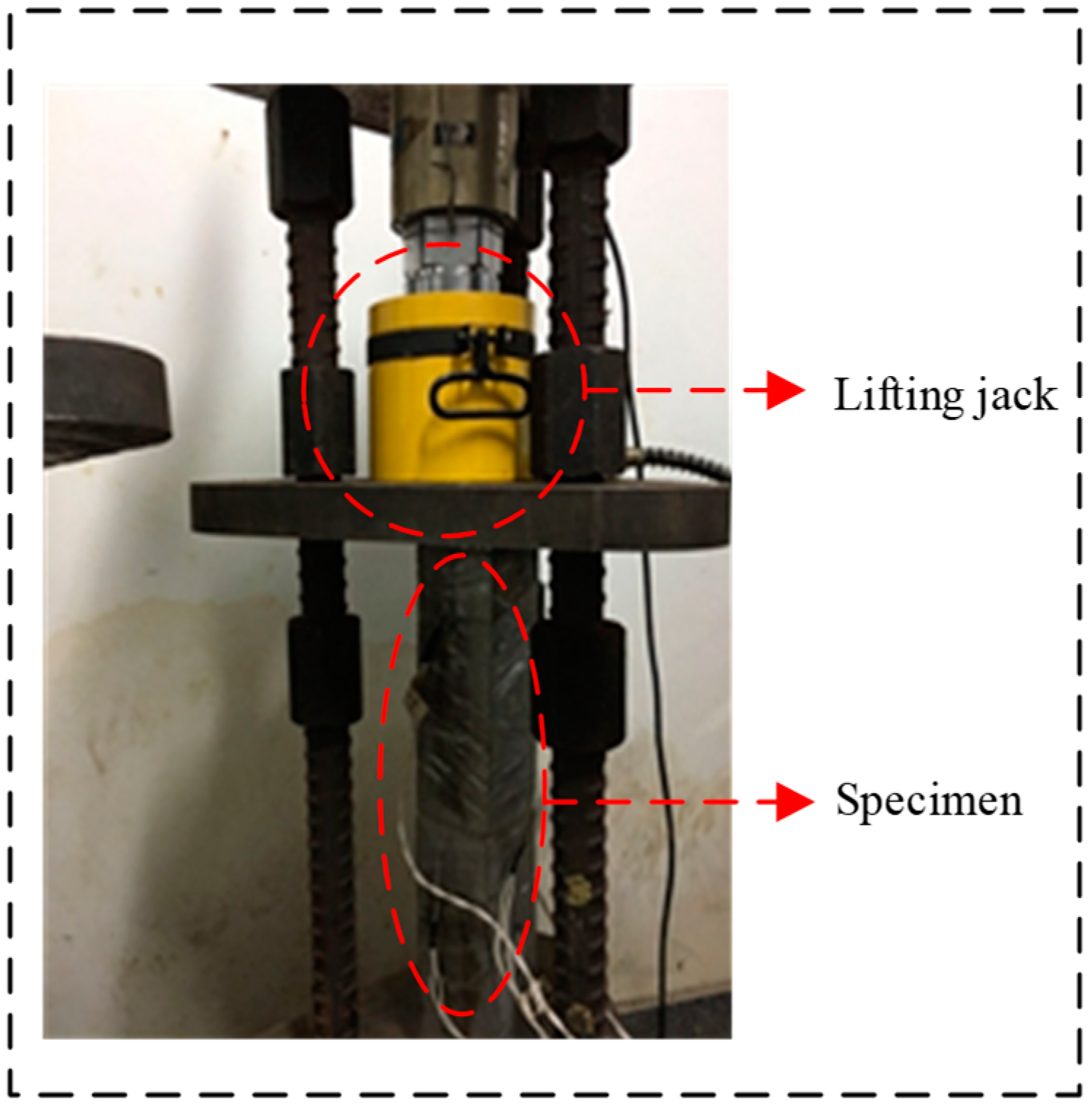
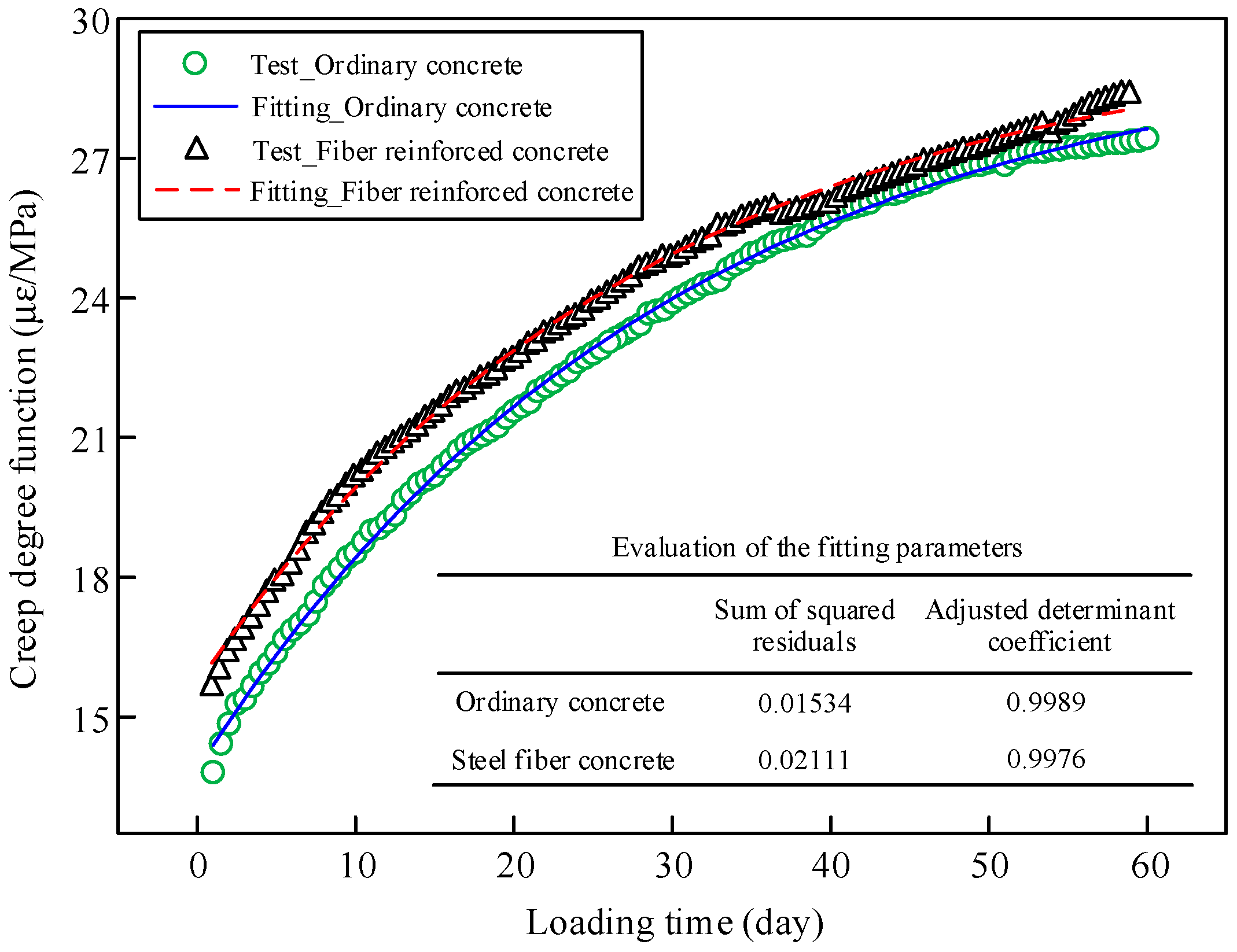


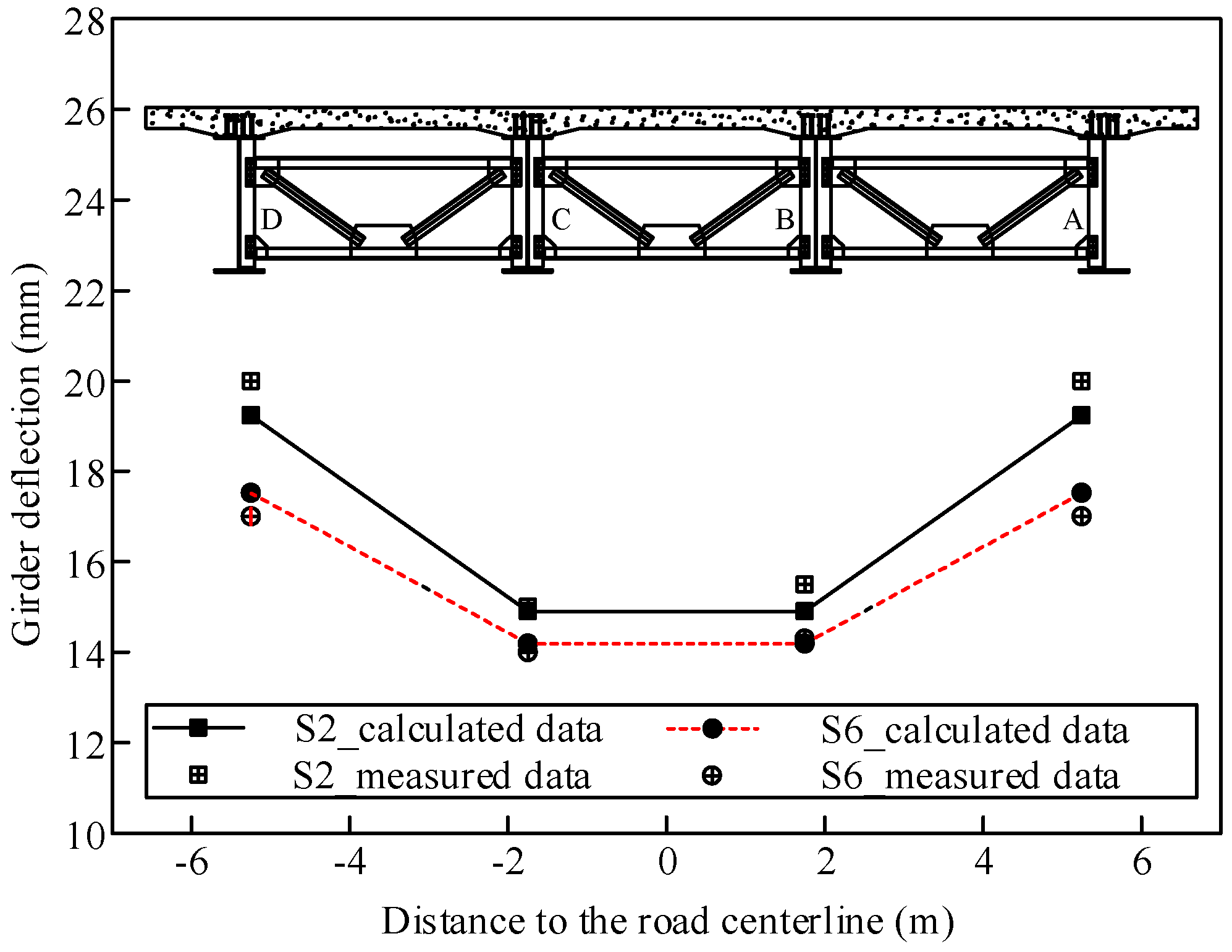
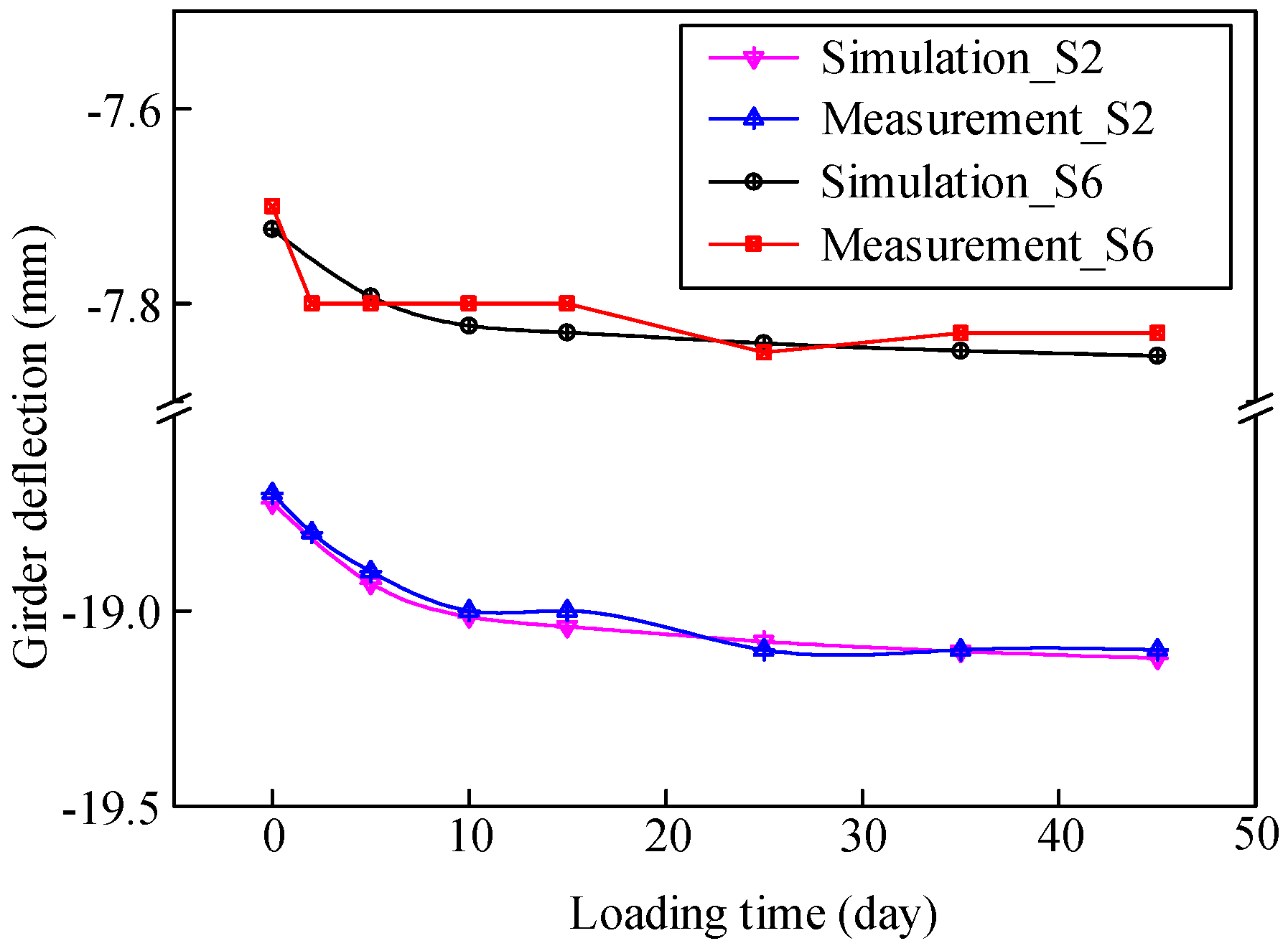



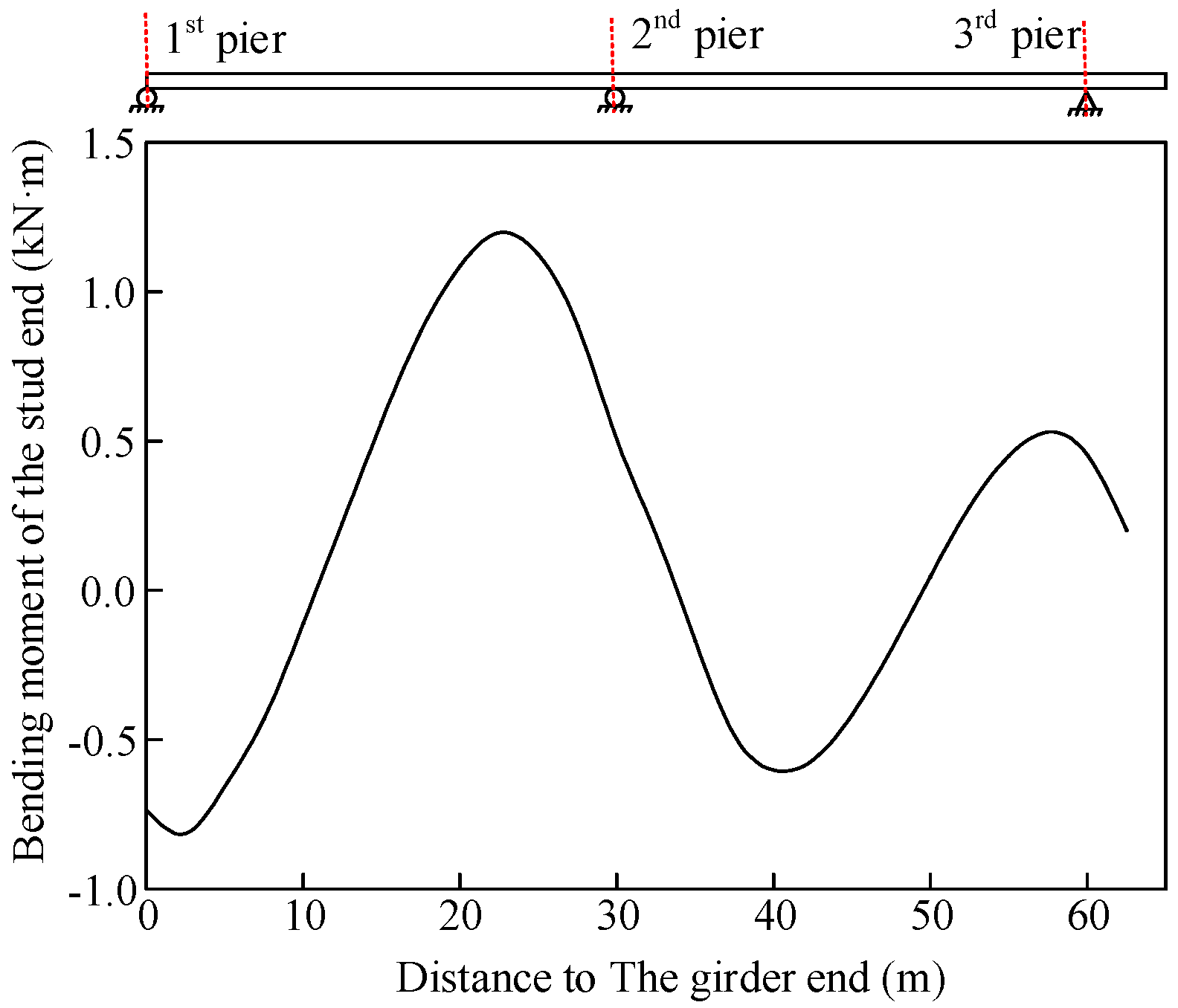

| Temperature of Each Measuring Point (°C) | |||||||||||||
|---|---|---|---|---|---|---|---|---|---|---|---|---|---|
| Section | Day | SC1 | SC2 | SC3 | SC4 | SC5 | SC6 | SC7 | SC8 | SC9 | SC10 | SI1 | SI2 |
| S4 | 1 | 4.90 | 5.10 | 4.60 | 5.00 | 5.40 | 4.70 | 5.00 | 4.70 | 4.50 | 4.10 | 2.90 | 2.60 |
| 2 | 11.40 | 12.60 | 11.60 | 12.40 | 11.50 | 11.90 | 11.60 | 12.20 | 10.20 | 8.30 | 8.20 | 7.40 | |
| 3 | 11.40 | 11.20 | 11.00 | 11.40 | 11.30 | 11.50 | 11.7 | 11.70 | 9.20 | 8.50 | 8.10 | 7.20 | |
| 4 | 9.90 | 11.60 | 10.90 | 11.50 | 11.40 | 11.50 | 12.30 | 9.90 | 10.80 | 9.00 | 9.20 | 8.90 | |
| 5 | 7.60 | 8.30 | 8.50 | 8.10 | 8.50 | 8.30 | 8.30 | 7.50 | 7.70 | 6.50 | 4.30 | 3.90 | |
| 6 | 7.60 | 8.40 | 8.10 | 8.40 | 8.30 | 8.60 | 8.40 | 7.40 | 7.60 | 6.30 | 4.40 | 4.00 | |
| 7 | 8.50 | 9.90 | 9.20 | 9.80 | 9.70 | 9.60 | 9.90 | 8.30 | 9.40 | 8.10 | 5.50 | 5.40 | |
| S6 | 1 | 4.90 | 5.10 | 6.60 | -- | 6.70 | 6.20 | 6.50 | 5.50 | 5.00 | 5.60 | 4.80 | 4.60 |
| 2 | 13.00 | 14.20 | 14.20 | -- | 14.80 | 14.70 | 14.90 | 13.50 | 10.10 | 10.10 | 9.00 | 8.50 | |
| 3 | 10.70 | 12.40 | 12.40 | -- | 12.60 | 13.70 | 14.20 | 13.40 | 13.70 | 12.90 | 10.00 | 9.40 | |
| 4 | 12.20 | 13.40 | 13.40 | -- | 14.10 | 14.00 | 13.70 | 11.10 | 12.20 | 11.70 | 10.60 | 10.20 | |
| 5 | 8.70 | 9.50 | 9.50 | -- | 9.60 | 9.90 | 9.30 | 8.80 | 8.30 | 7.50 | 6.50 | 6.10 | |
| 6 | 8.90 | 9.60 | 9.60 | -- | 9.60 | 9.80 | 9.40 | 8.80 | 8.30 | 7.50 | 6.50 | 6.10 | |
| 7 | 9.90 | 11.40 | 10.70 | -- | 11.50 | 11.70 | 11.60 | 10.60 | 10.40 | 10.80 | 8.90 | 8.70 | |
| Average | 9.26 | 10.19 | 10.02 | 9.51 | 10.36 | 10.44 | 10.39 | 9.53 | 9.10 | 8.35 | 7.06 | 6.64 | |
| Specimen | A0 | A1 | m |
|---|---|---|---|
| Ordinary concrete | 29.713 | −15.847 | 29.491 |
| Steel fiber concrete | 29.025 | −12.717 | 28.149 |
| Casting Segment | Casting Area | Date |
|---|---|---|
| I | Positive bending moment zone of the fourth span | 9 a.m., 23 April 2018 |
| II | Positive bending moment zone of the third span | 9 a.m., 24 April 2018 |
| III | Positive bending moment zone of the second span | 2 p.m., 24 April 2018 |
| IV | Positive bending moment zone of the first span | 9 a.m., 25 April 2018 |
| V | Negative moment zones of the third and fourth spans | 2 p.m., 25 April 2018 |
| VI | Negative moment zones of the second and third spans | 9 a.m., 27 April 2018 |
| VII | Negative moment zones of the second and first spans | 12 a.m., April 27, 2018 |
| Casting Segment | Calculated Strain (με) | Measured Strain (με) | Error Percentage (%) | |||
|---|---|---|---|---|---|---|
| Bottom Plate | Top Plate | Bottom Plate | Top Plate | Bottom Plate | Top Plate | |
| I | −5.1 | 6.4 | −3.5 | 4.4 | 45.71 | 45.45 |
| II | 16.9 | −12.5 | 12.7 | −14.6 | 33.07 | −14.38 |
| III | −62.7 | 57.5 | −53.2 | 46.2 | 17.86 | 24.46 |
| IV | −130.4 | 124.9 | −110.4 | 100.0 | 18.12 | 24.90 |
| V | −87.3 | 124.5 | −101.4 | 93.2 | −13.91 | 33.58 |
| VI | −119.9 | 124.9 | −130.1 | 109.5 | −7.84 | 14.06 |
| VII | −131.1 | 118.2 | −161.3 | 130.5 | −18.72 | −9.43 |
| Casting Segment | Calculated Strain (με) | Measured Strain (με) | Error Percentage (%) | ||||||
|---|---|---|---|---|---|---|---|---|---|
| Bottom Plate | Top Plate | Concrete Slab | Bottom Plate | Top Plate | Concrete Slab | Bottom Plate | Top Plate | Concrete Slab | |
| I | −5.3 | 5.3 | 0.0 | −8.4 | 6.5 | 0.0 | 36.90 | 18.46 | -- |
| II | 11.4 | −9.5 | 0.0 | 13.6 | -9.5 | 0.0 | 16.18 | 0.00 | -- |
| III | −47.3 | 28.7 | 0.0 | −58.5 | 31.8 | 0.0 | 19.15 | 9.75 | -- |
| IV | 202.0 | −50.9 | −120.5 | 239.1 | −73.9 | −120.4 | 15.52 | 31.12 | 0.08 |
| V | 202.4 | −51.0 | −120.5 | 245.2 | −62.0 | −126.8 | 17.46 | 17.74 | −4.97 |
| VI | 202.0 | −50.8 | −120.5 | 238.8 | −61.8 | −132.4 | 15.41 | 17.80 | −8.99 |
| VII | 199.1 | −45.9 | −120.8 | 240.1 | −75.9 | −136.4 | 17.08 | 39.53 | −11.44 |
© 2020 by the authors. Licensee MDPI, Basel, Switzerland. This article is an open access article distributed under the terms and conditions of the Creative Commons Attribution (CC BY) license (http://creativecommons.org/licenses/by/4.0/).
Share and Cite
Wang, G.-M.; Zhu, L.; Zhou, G.-P.; Han, B.; Ji, W.-Y. Experimental Research of the Time-Dependent Effects of Steel–Concrete Composite Girder Bridges during Construction and Operation Periods. Materials 2020, 13, 2123. https://doi.org/10.3390/ma13092123
Wang G-M, Zhu L, Zhou G-P, Han B, Ji W-Y. Experimental Research of the Time-Dependent Effects of Steel–Concrete Composite Girder Bridges during Construction and Operation Periods. Materials. 2020; 13(9):2123. https://doi.org/10.3390/ma13092123
Chicago/Turabian StyleWang, Guang-Ming, Li Zhu, Guang-Pan Zhou, Bing Han, and Wen-Yu Ji. 2020. "Experimental Research of the Time-Dependent Effects of Steel–Concrete Composite Girder Bridges during Construction and Operation Periods" Materials 13, no. 9: 2123. https://doi.org/10.3390/ma13092123
APA StyleWang, G.-M., Zhu, L., Zhou, G.-P., Han, B., & Ji, W.-Y. (2020). Experimental Research of the Time-Dependent Effects of Steel–Concrete Composite Girder Bridges during Construction and Operation Periods. Materials, 13(9), 2123. https://doi.org/10.3390/ma13092123




